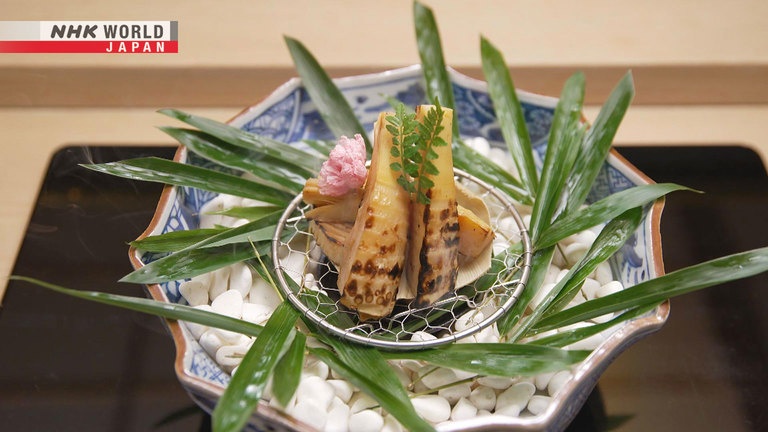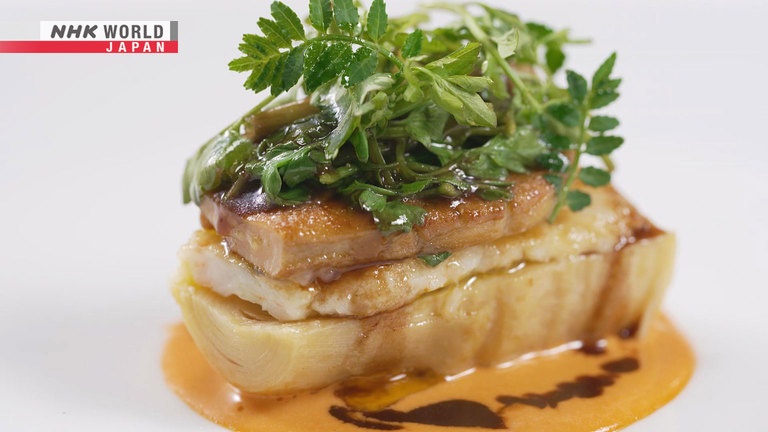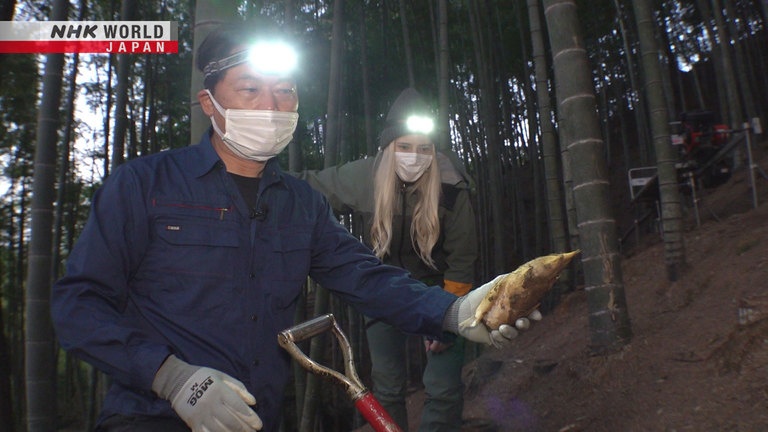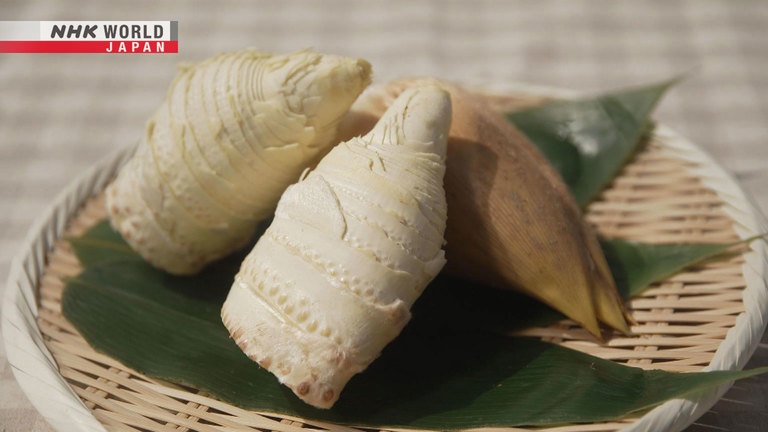TAKENOKO
Takenoko, or bamboo shoots, are the flavor of spring. Our reporter Janni is put to work on a steep grove where skill and timing are key to harvesting young stems before they harden in direct sunlight. Afterward, enjoy the various textures and flavors the ingredient adds to exquisite Japanese cuisine, and see how it's used in place of meat in innovative French dishes. (Reporter: Janni Olsson)




Transcript
Tokyo: this world-class metropolis is a veritable gourmet wonderland.
Discover the stories behind the ingredients that make this city so delicious - so "oishii."
In Japan, takenoko are the taste of spring.
Takenoko are young bamboo shoots.
Bamboo's durability makes it perfect for baskets or other common goods.
It has deep roots in Japanese tradition.
Because bamboo is one of the fastest-growing plants on earth, lovely bamboo decorations symbolize longevity and prosperity during New Year's.
And takenoko play a key role in Japanese cuisine.
There it is!
It's like a treasure hunt.
Dig up young shoots that haven't been exposed to sunlight...
How nice.
And enjoy a crunch and flavor that'll put a smile on your face.
People wait all year long for this taste of spring, takenoko.
"Oishii."
Trails to Oishii Tokyo.
Hello. My name is Janni Olsson, and I am from Sweden.
Now, what you can see all around me here is bamboos.
And the theme of today's show is called "takenoko," which is actually the shoots of these bamboo.
But what is this ingredient like?
Let's go and find out some more.
Janni begins in Akasaka, Tokyo - home to many upscale shops.
She's heading to a traditional Japanese restaurant on a main street.
Hello.
Tanaka Masaru goes directly to production areas to carefully select his takenoko.
We don't eat much takenoko in Sweden.
Is it popular in Japan?
Yes.
It's the flavor of spring.
It's eaten from March to early May.
The peak is during cherry blossom season.
That's when it tastes the best.
That's not so long.
Right. You can only eat it fresh
for two months out of the year.
You can enjoy a
taste of the season.
The character for takenoko combines the characters for "take," meaning "bamboo," and "shun," meaning "season."
"Shun" also means "a ten-day period."
Bamboo shoots harden after 10 days, so they can only be enjoyed for...
can you guess?
One shun!
They are truly a spring ingredient.
But you can't eat them raw.
Takenoko are quite bitter, so they need to be prepped first.
Cut off the tip at an angle, leaving about four-fifths of the shoot behind, and make a small incision at the top.
This helps release bitterness, and they cook faster too.
Add takenoko, powdered rice bran, and a chili pepper to a pot, and bring it to a boil.
The bran suppresses a nutrient that causes bitterness.
And the chili pepper offers antibacterial properties.
Let them boil for about an hour.
Takenoko are boiled in their skin to retain umami.
They need to soak for about 10 hours after boiling.
Then rinse the bran off, and you're good to go.
- It takes quite a while.
- It does.
The skin is taken off to reveal a yellow shoot.
Cut off the hard tip.
Here's a cross section.
This one piece actually has three different textures.
The tips of young shoots have a
tenderness you can enjoy first.
The center has a firmer texture,
and more so towards the bottom.
That makes them fun to eat.
Boiling takenoko with wakame seaweed is a great way to savor the different textures.
The shoots are cooked in a broth containing sake, kombu kelp and other spring ingredients like rape blossoms.
This is served with stir-fried wakame seaweed.
Janni starts at the bottom of the shoot.
"Oishii." Great texture.
It has a slight crunch to it.
Now the soft tip.
It's so nice and juicy.
It soaked up the tasty dashi.
"Oishii!"
It's light and refreshing.
Preparing takenoko in different ways brings out different textures and flavors.
It's cooked over charcoal and covered with soy sauce, providing an aroma and sweetness similar to grilled corn.
I could eat this all day.
Takenoko tempura with spring veggies.
Sakura salt provides a slight cherry blossom aroma that accents the takenoko's flavor.
Sweet and tasty.
The crunchy outside and tender core
offer another nice texture contrast.
Cooking it different ways brings out
different textures, flavors and aromas.
It's quite a fun ingredient!
I see it as a type of Japanese soul food.
I try to make it even softer, milder and tastier.
It's a versatile ingredient I experiment with every year.
How nice.
To learn more, Janni visits Toyosu Market, Tokyo's major produce hub.
The market receives around 170 metric tons of takenoko in both March and April, when they're in season.
Hello!
Oh, hello.
Wholesaler Kondo Yoshiharu offers one of the widest selections of fruits and veggies in the market.
You have a lot of takenoko.
We get the most for about a month
starting from the spring equinox.
Janni has arrived in late March.
Available from then to early May is a type called "moso."
Japan currently has over 10 types of takenoko.
Domestic consumption dates back millennia, with mention in Japan's oldest historical record, The Kojiki, from around 1,300 years ago.
Brought from China some 300 years ago, "moso" came to be loved for its plump, soft texture and mild flavor.
Domestic cultivation soon took off.
Its growing popularity gave birth to a variety of dishes, especially in Edo where people loved eating foods in season.
Today, most takenoko on the market are from "moso."
"Moso" tastes the best too.
- Really?
- Yes.
How do you determine the flavor?
I bet the one you're holding tastes good.
How do you know?
"Moso" have outer hair.
Shiny hair is a good sign.
It's nice and shiny, like a cat.
For takenoko, tenderness is key.
That means that as long as they're
still in the soil, they're soft and tasty.
A yellow tip proves it wasn't exposed to sunlight.
When exposed to sunlight,
they take on a darker green color.
A rounder shape means they're dense.
And a white, moist center means they're very fresh.
There are many things to look out for.
At the start of spring, takenoko shipments begin coming in from the south.
Kondo says takenoko from Kyushu and Kyoto are popular, but a certain area close to Tokyo really piques his interest.
Otaki in Chiba is a quality takenoko
production area near Tokyo.
Is that so?
- This is from Otaki.
- I see.
Otaki takenoko reach Tokyo markets only one day after harvest, so they're very fresh.
Something like 1% of takenoko
harvested there are white takenoko.
It's a variety that has no bitterness
or acidic qualities at all.
So, it's eaten raw locally.
Like sashimi?
I'm intrigued.
But only 1%...
Can I find some? I want to try it.
We don't come across it here.
- So it's pretty rare.
- Yeah.
- Challenge accepted.
- Have some for me.
I'll try!
Thank you!
In search of white takenoko, Janni heads to Chiba, next to Tokyo.
Otaki is in south-eastern Chiba.
Being 70% forest cover, the area provides a rich takenoko harvest.
She arrives in mid-March, the start of takenoko season.
Customers are lined up outside a farmer's market in the morning.
Good morning. Sorry for the wait.
They've come for takenoko.
They rush to the dedicated shelf.
Sales can reach over 500 kilograms in one day.
It's that time of year they've all been waiting for.
I have to eat it at least once a year!
I understand!
It's the best.
The texture is like a pear.
I look forward to it every year.
Janni visits a producer known for growing a large amount of white takenoko.
They meet at 4:30 in the morning, before the sun comes up.
Good morning.
Morning!
I heard you grow delicious takenoko.
You start this early in the morning?
Right. I want to supply ones that
are dug out first thing in the morning.
- We need proper gear for the bamboo grove.
- Oh yeah?
Kimizuka lends her some cleated boots.
What will he have her do?
Headlamps ready, they head to the hill out back.
This is my grove.
That's quite a slope.
They set off to work on the steep 45-degree slope.
Janni searches, but doesn't see any takenoko.
I don't see any takenoko.
- Are there any?
- Of course!
They're still in the ground,
where there are cracks.
Look here. See?
There's an opening.
That's what we're looking for?
Right, where the soil separates.
Where it seems like something might be inside.
Exactly.
There it is!
Here we are.
She sees a yellow tip.
It's seeing sunlight for the first time.
This is tough work!
- It's like a treasure hunt.
- It really is.
Takenoko grow on a rootstalk attached to a parent stalk deep in the ground.
A shovel is used to separate the takenoko from the rootstalk.
How nice.
- Our takenoko.
- Great.
His grove is about 20,000 square meters.
For quality takenoko, the most important thing is choosing the best parent stalks.
I start to see nice takenoko
between early and mid-April.
But I refrain from digging them up.
Animals will eat them, so as they grow
taller, I keep them covered.
Those strong parent stalks
produce good takenoko.
Kimizuka thins out his crop to leave 20 to 30 parent stalks growing in every 10-meter area of land.
Parent stalks produce shoots for about five years.
Old ones are cut down after every harvest.
Prepping the soil is also key.
The ground here contains acidic white clay and rock fragments.
This produces takenoko that are milder and less bitter than ones grown in alkaline soil.
And the fine particles keep out light, and retain water and fertilizer.
Chicken manure and humus are added to boost fertility.
In winter, leaves cover the soil, keeping it warm and moist.
When March comes, they're blown away as the search for takenoko begins.
Some of the shoots grown in this controlled environment become top-quality, sweet and tender white takenoko.
That's so big.
- This is white takenoko.
- That's it?
Do you see the white roots?
Other bamboo have red roots.
The difference is like night and day.
It has creamy white skin and a pure white core all the way down to the roots.
The treasure hunt continues.
Looks good.
This is a big opening. What's that about?
- It's ready to come out.
- Yeah?
Oh, got it!
There it is!
Got it?
So this is white takenoko.
Nice.
Completely white. Wow.
Janni finds a big one that's about 25 centimeters long.
She tries a piece of the root, still raw.
It's sweet!
And very moist.
Juicier than expected.
Interesting.
This is a first for me.
You can eat it raw.
Absolutely.
Janni learns a fresh white takenoko recipe from Setsuko, Kimizuka's wife.
White takenoko isn't as bitter, so no prep is needed.
She cuts it in half and removes the skin.
Slice it up and boil it.
Add granulated soup stock and miso paste.
Wow! It's still crisp.
A similar aroma and sweetness to corn.
Because it's fresh.
It was used as-is, so the sweetness
and umami remain strong.
Next is Kimizuka's household favorite.
Pour soba noodle sauce over boiled takenoko.
Shake it up and let it marinate for about 10 minutes.
That's good.
Dip the slices in potato starch and fry them.
This is a family favorite.
It's great with alcohol.
I love it!
I've never tried this before.
It's addictive.
Super good.
Would be perfect with a drink, right?
I can't get enough.
It's rich.
Savory with a great aroma.
- I'm hooked.
- Great.
We also made rice and takenoko cooked in dashi, and even takenoko sashimi!
Every dish offered a unique takenoko flavor experience.
Janni's last stop is Shirokane, Tokyo, a classy gourmet and fashion district.
She visits a French restaurant mentioned in a gourmet guide book.
Hello.
I hear this is a French restaurant that uses takenoko.
Yeah. I use it a lot.
It grows underground like white asparagus,
so I use it in much the same way.
I see!
Owner chef Shibata Hideyuki specializes in French cuisine with a Japanese twist.
His first dish uses takenoko as the main ingredient.
He mixes finely chopped, marinated squid, shrimp paste, and sansho pepper - all spring ingredients.
He spreads that over a takenoko that's been cut in half, and pan fries it with rice flour to make it crispy.
Basting it with butter brings out the rich seafood umami as it absorbs into the takenoko.
He places it over a bed of sweet lobster sauce.
It's then topped with tender foie gras and some water celery for an added punch.
Takenoko skin smoked over straw is used as a garnish to provide a roasted fragrance.
A wonderful marriage of spring flavors from the sea and land.
I was wondering what was underneath.
- A surprise!
- Exactly.
It looks like the main dish, like a steak.
There's a traditional French dish that
combines beef fillet with foie gras.
I thought I'd use takenoko in place of meat
and make it the main feature of the dish.
- Nice sound.
- Right?
Very tasty. Excellent.
Tender and crispy textures.
Crispy takenoko.
An elegant mix of texture and flavor,
and it pairs great with the fois gras.
Impressive.
- Very satisfying without meat.
- I agree.
Next up is a dish featuring mild white takenoko.
Lovely color.
The creamy white color reminds me of spring.
There are three layers of takenoko: raw shoots on top, boiled slices in the middle,
and a thick, steamed piece on the bottom.
A savory cocktail of textures.
Janni starts from the top.
Light and refreshing.
What would you compare this to?
- I'd say fresh artichoke.
- Ah, that's it.
King crab risotto and black truffles placed between the takenoko add depth to the overall flavor.
I like the risotto. Very interesting.
It's layered with different textures and aromas.
It's like a full course in one dish.
It looks simple, but there's a lot
to discover under the surface.
I think takenoko farmers
have a tough, important job.
I often consider that while I'm cooking.
Takenoko is deeply rooted in Japan's food culture,
and is an exciting ingredient for chefs.
I want to keep finding new ways to use it.
When it comes to spring in Japan, people love looking at cherry blossoms and eating takenoko.
I realized that the blessings of spring, can only be enjoyed for a short time.
That's why people in Japan can't wait for their chance to enjoy them to the fullest.
Takenoko is a simple ingredient that brings profound results.
I need to try more takenoko dishes before spring is over!
In Tokyo, every ingredient has its own story.